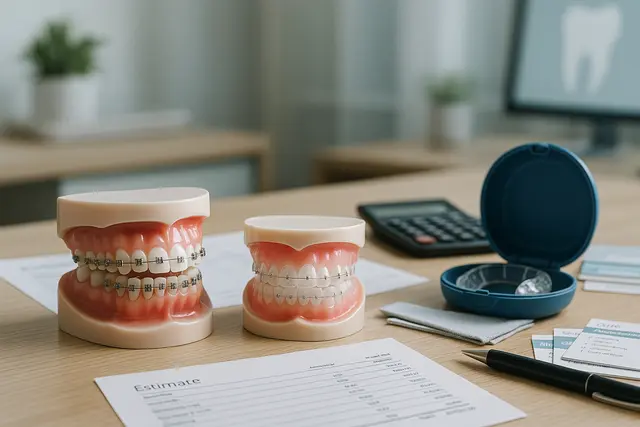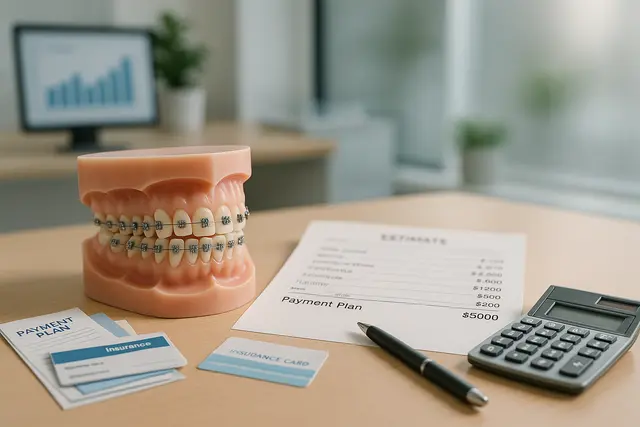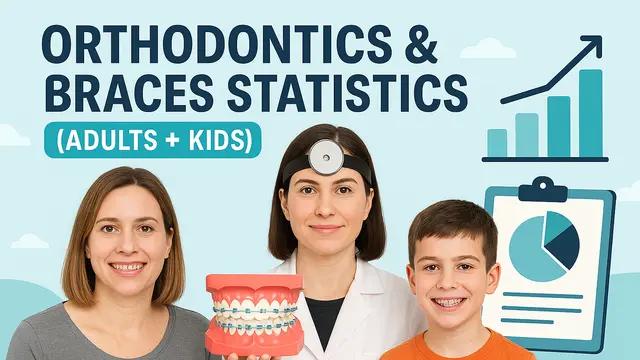Orthodontics
4 min read
Apr 03, 2025
Braces Before/After Gallery: Real Patient Smile Transformations
Improving your smile with braces is a process that takes time, consistency, and care. Seeing how real patients progressed can help you visualize potential outcomes and set realistic expectations.

Why a Confident Smile Changes Everything
Nothing lights up a room like a fearless smile, and our clinic has watched hundreds bloom. Peek into our smile gallery and you will see real patients who once hid crooked teeth now trading jokes with open‑mouth laughter.
Every image captures a leap of faith, a moment when someone decided to align the teeth for good. While results are not guaranteed, each new smile reminds us why we do what we do.
How Modern Braces Work – and Why Today’s Bracket Is No Big Deal
The word brace no longer signals heavy metal. The modern bracket is slim, shiny, and easy on gum tissue. We fit upper and lower braces in both traditional braces and metal braces styles, plus color ties that children and adults pick like candy. Some mouths start with phase I treatment, a gentle expander to widen a narrow arch, before phase II refines how the upper jaw and lower jaw meet.
A herbst appliance guides the lower jaw forward, and a crossbite corrector steadies the upper front teeth. Your orthodontist uses digital scans to customize orthodontic treatment so teeth to fit perfectly and stay put.
Invisalign: The Nearly Invisible Way to Straighten Teeth
If hardware makes you twitch, invisalign aligners slide on like clear raincoats. They are almost invisible at office lunch yet strong enough to close the space between a shy incisor and its molar neighbor. Because trays pop out at meals, tongue and gum tissue stay happy, and brushing feels normal.
Each set is mapped by computer, plotting the correct position for every tooth while keeping bite forces gentle. Adults love that they can straighten misaligned teeth without explaining a mouthful of metal during client calls.
Real Patients, Real Stories: Meet Ella, Marco, and Friends
Ella, age twelve, started with severe crowding that twisted her upper teeth and lower teeth into a narrow V. Braces to correct the mess lasted eighteen months; now her permanent teeth fit together like well‑rehearsed dancers.
Marco, a college senior with buck teeth, an overjet wide enough for a straw, and a bad bite, relied on an appliance to correct his bite in twenty‑four months. Each patient teaches us something new about timing, motivation, and perseverance.
Fixing the Bite: Getting Upper and Lower Teeth to Shake Hands
A bite is more than a grin; it’s the handshake between upper teeth and lower teeth. When the grip is off, jaws ache, molars crack, and headaches creep in. We tackle open bite from thumb‑sucking, deep bite that hides the lower teeth, overbite that nibbles cheek tissue, cross bite that shifts the lower jaw sideways, and excessive overbite that chips enamel. Sometimes braces and invisalign team up so upper and lower finally meet on equal terms.
Clearing the Crowd: Making Room in a Tight Smile
Crowding happens when the arch is too narrow for adult teeth, like too many books on one shelf. An expander can widen that arch before braces treatment, giving each incisor breathing room and preventing overlapping teeth later on. Once space opens, brackets guide every tooth back into line, making flossing feel less like threading a needle.
Closing Gaps: Sealing Those Pesky Spaces
Not every mouth is crowded; gaps pop up too. We use elastic chain on traditional braces or clear aligners to close the space, move teeth into the correct position, and keep gum tissue healthy. Beyond the cosmetic win, losing that whistle between front teeth feels glorious.
Solving an Open Bite: From Cheese‑Shredding to Pizza‑Biting
An open bite often appears when the tongue pushes between upper and lower during childhood. A habit trainer paired with brackets pulls the incisors together, letting you finally bite into pizza without shredding toppings mid‑air. Once the teeth touch, speech improves and chewing calms.
Deep Bite Dilemmas and the Tools That Lift Your Smile
A deep bite hides the lower teeth and can wear enamel thin. A bite‑lifting appliance lets the molars settle while finishing elastics align upper and lower until the jaws work like synchronized gears. By the finale, your jaw feels balanced and your smile looks broader.
Before‑and‑After Gallery: Scroll Through Jaw‑Dropping Changes
Our online gallery shows before and after photo sets of children and adults conquering everything from crossbite to severe crowding. Click any image to zoom, then slide to see the reveal. Notice braces to correct crooked teeth, nearly invisible invisalign trays hugging permanent teeth, and tricky open bite cases resolved with upper and lower braces plus a trusty appliance.
Your Next Step Toward a New Smile
Whether you choose expander, bracket, aligners, or metal braces, the mission is simple: achieve beautiful, healthy smiles that last. We study every bite, measure each arch, and adjust until alignment feels natural.
Every patient’s journey differs, and results are not guaranteed, but with the right orthodontic plan, and maybe a dash of humor, you could soon flash a brand‑new smile across every photo you take.
What Makes Modern Braces Different From the Ones We Grew Up With?
Today’s braces are smaller, smoother, and more comfortable than ever. Modern brackets come in sleek metal or ceramic styles and are paired with color ties patients can choose. Digital scans now customize treatment with incredible precision, making each phase, from expanders to elastics, more efficient and less intrusive.
How Do Invisalign Aligners Work to Straighten Teeth?
Invisalign uses a series of clear, removable trays designed to shift your teeth gradually. Each set is mapped digitally to guide your teeth into place while being gentle on your bite and gums. They’re discreet, easy to clean around, and popular with adults who want to avoid visible braces during work or social events.
What Kinds of Bite Problems Can Braces or Aligners Fix?
Orthodontic treatment can correct a wide range of bite issues, including overbites, crossbites, open bites, and deep bites. Appliances like expanders or habit trainers may be used along with braces or aligners to guide jaw growth and improve the way your upper and lower teeth fit together.
Can Braces or Aligners Help With Crowding or Gaps?
Yes. Crowded teeth are treated by widening the arch and carefully aligning each tooth using braces or aligners. Gaps are closed using elastic chains or aligner pressure. Both conditions are corrected not just for aesthetics, but to improve oral health, speech, and ease of cleaning.
Read Next
Related Posts

Orthodontics
Retainer That Looks like Braces: Benefits for Long-Term Alignment
A retainer might not get as much attention as braces, but it plays a crucial role in maintaining your smile after orthodontic treatment. Whether you're new to retainers or curious about the type that looks like braces, understanding their purpose and benefits is key to keeping your teeth aligned for the long haul.
6 min read
Sep 15, 2025

Orthodontics
How Much Are Metal Braces? Cost Comparison With Other Options
Thinking about getting braces but overwhelmed by the cost? You’re not alone. Orthodontic treatment can be a major investment, and understanding the different price points, from metal braces to clear aligners, can help you make a smart, confident decision.
5 min read
Sep 15, 2025

Orthodontics
Orthodontics & Braces Statistics (Adults + Kids)
Orthodontics has transformed from a niche medical service for teenagers into a booming sector that spans all ages. Today, both adults and children seek orthodontic treatment to improve their smiles, fix bite issues, and boost self-confidence.
4 min read
Aug 21, 2025
Don’t have time to research every dentist around you?
See why 30k+ patients trusted us